Chariot Carriers Captain XL, Corsaire XL User Manual
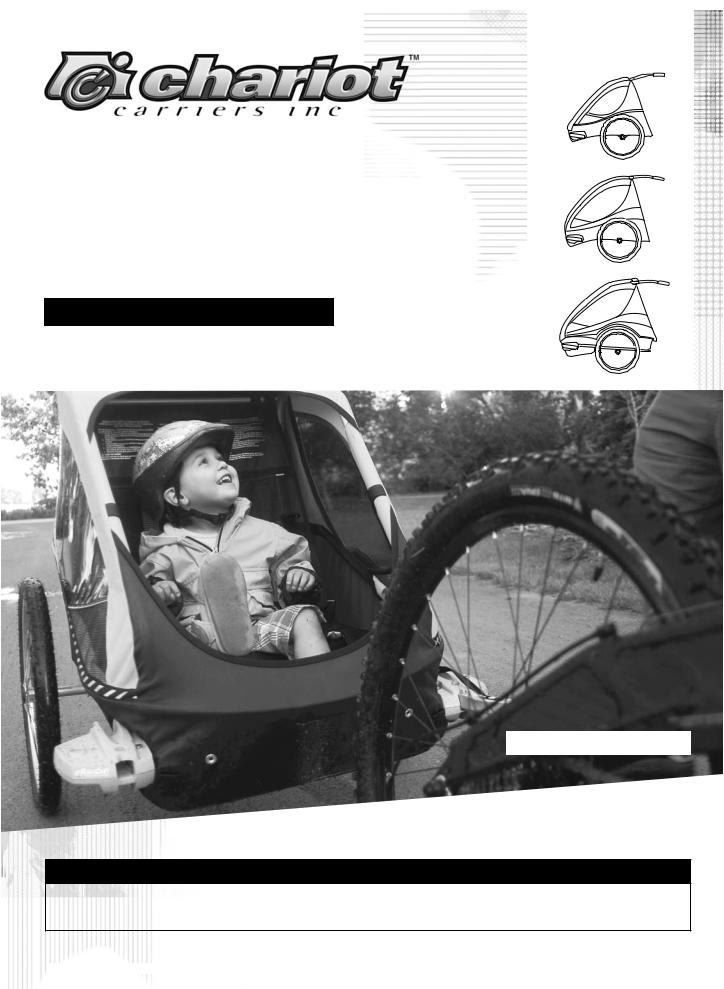
OWNER’S MANUAL
Cabriolet, Corsaire XL, Captain XL
Original Manual
Keep in a safe place for later reference
www.chariotcarriers.com
DANGER
You should not use the Chariot child carrier before you have read and understood the contents of this Owner’s Manual. Failure to follow this warning may result in serious or fatal injury.
Date of issue: 07/2006
„Zwei plus zwei“ Marketing GmbH Stolberger Straße 1
D-50933 Köln
Telefon: +49 - 2 21 - 95 14 70 - 0 Telefax: +49 - 2 21 - 95 14 70 - 20 E-Mail: info@zweipluszwei.com
„Zwei plus zwei“ Marketing GmbH retains all rights to this Owner’s Manual.
No texts, details or illustrations from this Manual may be either reproduced or distributed, or indeed become the subject of unauthorised use for commercial purposes, nor may they be made available to others.
Additional Manuals for using this trailer may be ordered as separate items from „Zwei plus zwei“ Marketing GmbH or downloaded from www.zweipluszwei.com.
Great care has been taken in assembling this Manual. Nevertheless, should you discover any errors, we would be grateful if you could bring them to our attention.
Manual compiled by:
prodek GmbH Stolberger Straße 1 D-50933 Köln
Telefon: +49 - 2 21 - 95 14 70 - 40 Telefax: +49 - 2 21 - 95 14 70 - 61 E-Mail: kontakt@prodek.de
www.prodek.de
Table of Contents |
|
|
1.General Items........................................................................ |
3 |
|
2.Overview of Components...................................................... |
4 |
|
3.Safety.................................................................................... |
4 |
|
3.1 |
Explanation of symbols and instructions........................... |
4 |
3.2 |
General safety instructions................................................ |
5 |
3.3 |
Safety information for all travelling situations.................... |
5 |
3.4 Safety instructions for carrying infants................................. |
6 |
|
3.5 |
Safety instructions for maintenance and repairs............... |
6 |
3.6 |
Warning against unauthorised modifi cations..................... |
6 |
4.Description of the Ready Chassis......................................... |
6 |
|
4.1 |
Supplied as standard........................................................ |
6 |
4.2 Assembly and folding up................................................... |
6 |
|
4.3 |
Wheel assembly................................................................ |
8 |
4.4 |
Fitting the handlebar.......................................................... |
9 |
4.5 |
Seat and seatbelts............................................................ |
10 |
4.6 |
Climate control.................................................................. |
12 |
4.7 |
Parking brake.................................................................... |
14 |
4.8 Adjusting the suspension (Corsaire XL and Captain XL).. |
16 |
|
5.The Cycling Kit...................................................................... |
17 |
|
• Safety instructions for use as a Bicycle Trailer........................... |
17 |
|
6.The Jogging Kit..................................................................... |
26 |
|
• Safety instructions for use as a Jogging Stroller.................. |
26 |
|
7.The Strolling Kit..................................................................... |
29 |
|
• Safety instructions for use as a Stroller............................... |
29 |
|
8.The Hiking Kit........................................................................ |
31 |
|
• Safety instructions for use as a Hiking Carrier,,,,,,,,,,,.......... 31 |
||
9.The XC Skiing Kit.................................................................. |
33 |
|
• Safety instructions for use as an XC Skiing Carrier............. |
33 |
|
10.The Walking Kit................................................................... |
36 |
|
• Safety instructions for use as Walker................................... |
36 |
|
11.Accessories......................................................................... |
38 |
|
12.Service, Care and Storage.................................................. |
38 |
|
13.Specifi cations...................................................................... |
39 |
|
14.Warranty and Guarantee..................................................... |
39 |
|
2
1. General Items
Congratulations on buying this child transporter!
You have decided to buy a product from the CTS-series (Child Transport System) of the Canadian manufacturer Chariot Carriers Inc.
Your new child transporter stands out because of its excellent quality, user-friendliness, high safety standards and great versatility.
The Child Transport System enables you go for bike rides, walks or jogging with your children without having to park a fl eet of special vehicles in the garage or basement.
It consists of a basic unit - passenger compartment with chassis, parking brake, handlebar, two 20” wheels (Cabriolet and Corsaire XL) or two 18“ wheels (Captain XL) and at least one of the following accessory sets:
•The Cycling Kit (hitch arm, hitch, front, rear and spoke re
flectors, safety fl ag) converts the base to a bicycle trailer
•The Jogging Kit (16“ front wheel with two wheel arms) converts the basic unit to a jogging stroller.
•The Stroller Kit (an 8“ stroller twin wheel) converts the basic unit to a stroller..
•The Hiking Kit (drawbar with shoulder strap) converts the basic unit to a hiker.
•The XC skiing Kit (- only Corsaire XL - skier and drawbar with waist strap) converts the basic unit to a sleigh hiker
•The Walking Kit (drawbar with waist strap) converts the basic unit to a walker.
Who is this Manual intended for?
This Manual is intended for the purchaser and user of the carrier, who is also responsible for keeping it in proper condition, carrying out maintenance as prescribed and performing repairs.
When using this carrier, please also follow the owner’s manual of the bicycle used for towing and the specifi cations given there regarding the maximum allowable full load for the bicycle.
Intended Use
Use as intended
The carrier is intended for use, within the performance ranges specifi ed above, for the carrying of children in daylight hours on sidewalks, light traffi c public roads, smooth paths, and beginner level ski trails. Luggage may also be carried in the storage bags intended for that purpose, provided the children in the carrier are not put at risk.
If the child carrier is used as a Bicycle Trailer in conditions of poor visibility, at dusk or in the hours of darkness, it is highly recommended to be retrofi tted with a safety approved working light set.
As part of the use as intended, you should also follow this Owner’s Manual and comply with the prescribed maintenance requirements.
Use not as intended
Any use that goes beyond the above is not as intended.
Use not as intended is primarily the conveying of people together with animals, use of this carrier on rough off-road terrain, use for commercial purposes, overloading, excessive speed and improper repair of defects or modifi cations.
The manufacturer is not liable for damages arising from use that is not as intended – this is at the risk of the user.
Performance characteristics of the Ready Chassis, valid for all CTS Conversion Kits
Cargo load |
45 kg/100 lb, |
|
maximum of 2 children |
Maximum age of the children, |
|
Corsaire XL, Captain XL |
6 Jahre |
Maximum body height of the children, |
|
Corsaire XL, Captain XL |
117 cm |
Maximum age of the children, |
|
Cabriolet |
4 Jahre |
Maximum body height of the children, |
|
Cabriolet |
103 cm |
3
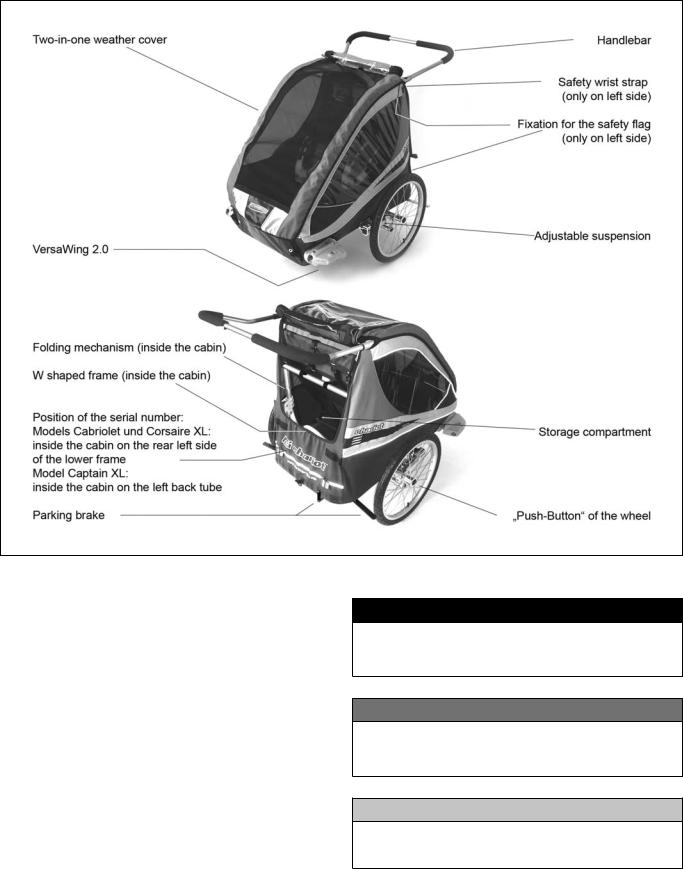
2. Overview of Components
3. Safety
The purpose of this section is to acquaint you with the symbols and safety instructions and make you aware of general dangers that might arise in using the carrier. In addition, here you will get to know about the particular dangers when using the carrier in road traffi c, as well as being warned against unauthorised rebuilds or modifi cations.
This section, which is entitled »Safety«, is the most important section in this Owner’s Manual. For this reason you need
to read through it with particular care and take note of all instructions.
3.1 Explanation of symbols and instructions
In this Owner’s Manual all items relating to safety are provided with a warning.
In the designation of the possible hazards, distinctions are drawn based on the severity of the possible harm that may arise.
DANGER
Here you will fi nd instructions where failure to comply may result in risk to health, life and limb, both of the user and of the occupants of the carrier.
WARNING
Instructions introduced with this symbol indicate possible risk of material damage. Failure to heed this warning may result in material damage.
TIP
Here you will fi nd instructions that will make using the product easier for you.
4
3.2 General safety instructions
Basics
•Before using the carrier, please read through the Owner’s Manual carefully. Failure to comply with the safety instructions may result in serious personal injury or death, to both the user and/or the occupants of the carrier.
•When using the carrier, always comply with local safety and accident prevention regulations, as well as the local Road Traffi c Act, all of which may restrict use in some way.
•Safe and appropriate use of the carrier is your responsibility. Before using the carrier for the fi rst time, acquaint yourself with its handling characteristics away from public roads and without carrying children. An empty carrier will tip over more easily when going over obstacles with one wheel only than one carrying a load. A fully loaded carrier makes greater demands on the deceleration devices.
•Negotiate inclines and corners with the utmost caution and reduce speed when doing so.
As regards the children carried
•Never leave your child unsupervised in the carrier.
•Regularly check that your children are appropriately clothed and that they feel comfortable especially in hot and cold temperatures.
•Only children who can sit up without support may be carried, unless the Chariot Infant Sling is used.
•The maximum height of children who may be carried is: 103 cm for the Cabriolet, 117 cm for Captain XL and Corsaire XL
•In carriers maximum two children maybe carried.
•Make sure that the limbs, clothing or toys of the child do not come into contact with the carrier wheels or the rear wheel of the towing bicycle.
As regards the carrier
•Never carry any heavy or sharp protruding items in the storage space of the carrier if you are also carrying children at the same time (risk of injury on braking).
•Items of luggage should be well secured so that they cannot move around during the journey. Unsecured items of luggage and overloading reduce riding stability and make the carrier more diffi cult to handle.
•The carriers are bicycle carriers and must never be towed behind motorised vehicles.
•The carriers must not be carried on the roof of a vehicle, even when folded, as they will get damaged.
•At various points on the carrier, self-locking nuts are used. If these have been loosened they must not be reused. Once they have been loosened they lose their original function, and this can lead to unexpected loosening of the screw connection with potentially serious consequences.
•Do not use the carrier at temperatures below -20°C /-4°F and do not store it at these temperatures. The windows may break.
•When folding up or opening the carrier, there is a risk of pinching your hand or fi ngers.
As regards the children in the carrier
•When converting with other CTS Conversion Kits, no child should be sitting in the carrier, nor when carrying out maintenance or repair work.
•The permitted total cargo load of the carrier is limited to 45 kg. This must never be exceeded. The cargo load is the weight of the children together with any luggage there might be.
•Please explain to your child that he/she must not bounce, fi dget or lean out of the carrier.
3.3 Safety information for all travelling situations
As regards the children carried
•Never carry items of luggage on the seat next to your child.
•Never carry animals together with your children.
As regards the carrier
•Take care when travelling over uneven surfaces. The carrier can overturn if driven with one wheel only across uneven ground, even at very low speed.
•In the event of the carrier tipping over, the handlebar acts as a safety bar. For this reason keep it permanently fi tted.
•Before each journey check the tire pressure. The minimum recommended pressure is 30 psi (2.1 bar) and the maximum is 35 psi (2.5 bar). Even if a higher pressure is permitted
for the tires fi tted, the Manufacturer recommends that
35 psi (2.5 bar) not be exceeded. Air pressure that is too high considerably reduces the comfort of the children, especially on carriers without suspension.
•Do not use compressed air lines (e.g. at service stations). The tyres may burst due to the small volume of the tubes.
•Never go up or down steps with the carrier.
•Before each journey check that the wheels are fully engaged.
•Before each journey check that the folding auto-lock disk is fully engaged.
•Before each journey check that the spring buttons of the handlebar are fully engaged.
As regards the children in the carrier
•Never carry your children without fastening all the seatbelts in the proper manner, otherwise your child could be seriously or even fatally injured in the event of an accident. Always make sure the seatbelts are properly adjusted to the height of your child.
•When travelling faster than walking pace, always use at the very least the mesh component of the two-in-one weather cover.
•As the children get in and out, the parking brake must be on to prevent the carrier from accidentally rolling away.
5

3.4 Safety instructions for carrying infants
•Children who cannot as yet sit up without support may only be carried using the Chariot infant Sling (accessory).
•The Manufacturer accepts no liability for use of other sitting aids or baby seats.
•Please make sure you follow the safety instructions in the Chariot Infant Sling Owner’s Manual
3.5Safety instructions for maintenance and repairs
•The maintenance work specifi ed (see Section 12) is absolutely essential for the long-term safe operation of the carrier.
•Only use original spare parts. When replacing safety-related parts, such as the frame, wheels, hitcharm and fabric, only have this carried out by an Authorized Chariot Retailer.
•Regularly check all safety-related parts, such as the frame, wheels, hitcharm and fabric, for damage or tearing. At the
fi rst sign of damage have the relevant part replaced by your Authorized Chariot Retailer.
•Tears in the fabric actually represent a high safety risk. Due to tears in the fabric your child could come into contact with the wheels or the road surface.
•If you fi nd a tear in the fabric, stop using and contact your Authorized Chariot Retailer immediately: the fabric can either be repaired or replaced.
•Never try to straighten out bent safety-related parts such as the frame, wheels or hitcharm. Have the relevant part replaced by your Authorized Chariot Retailer. There is a risk of it cracking and subsequently breaking.
•We recommend annual maintenance of the wheels by your Authorized Chariot Retailer.
3.6Warning against unauthorised modifications and additions
•Unauthorised rebuilds or modifi cations of the carrier are not permitted for reasons of safety and render the warranty invalid.
•The fi tting of a car safety seat or other seats or seat supports that do not carry the express approval of the Manufacturer is not permitted.
•Do not fi t any additional parts, such as a luggage rack, for instance, that do not carry the express approval of the Manufacturer.
•The carrying of pedal cars, which are attached to the handlebar or some other part of the carrier, is not permitted.
4. Description of the Ready Chassis
4.1 Supplied as standard
Passenger compartment with two-in-one weather cover folded up, two 20” wheels (Cabriolet and Corsaire XL) or two 18“ wheels (Captain XL), handlebar and parking brake
4.2 Assembly and folding up
Transport strap lock (only on the Cabriolet and Corsaire XL)
To be able to assemble the passenger compartment, you fi rst need to undo the transport strap lock.
You can use the strap lock anytime for holding the carrier fi xed in its folded state.
6
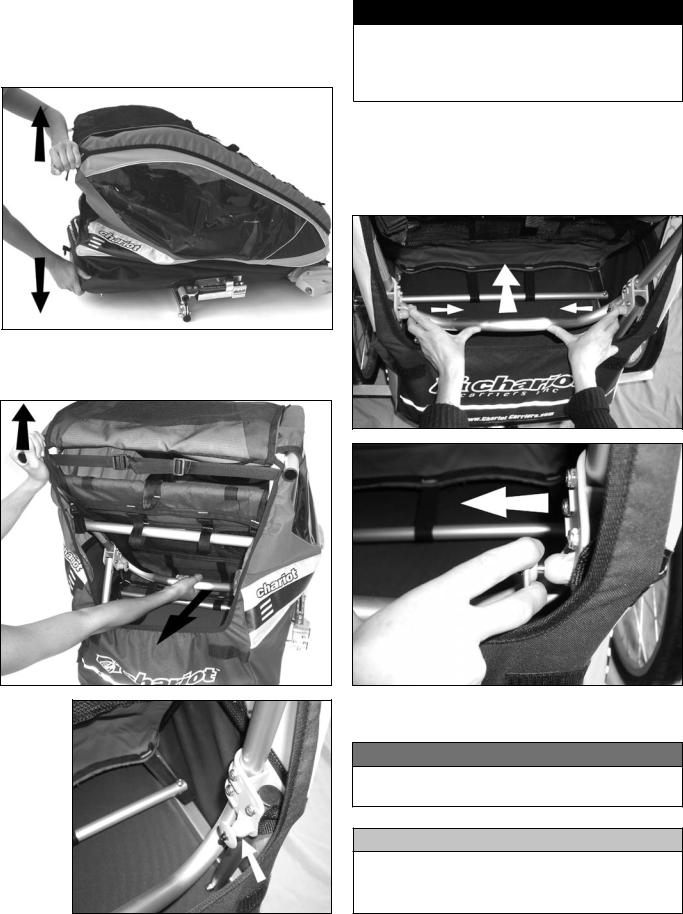
Assembly of the carrier
With one hand, lift the rear end of the top frame tube upwards, at the same time as holding the bottom part of the rear of the carrier with the other hand.
Pull the W shaped frame rearwards, until the frame is fully uprighted and both right-hand and left-hand auto-lock disks audibly engage.
auto-lock disk
DANGER
Before each journey make sure that both auto-lock disks are engaged. If this does not happen, the passenger compartment may collapse unintentionally and injure your child or cause you to lose control of the carrier.
Folding up the carrier
To fold up the carrier, pull on both auto-lock disks simultaneously, at the same time as pushing the W shaped frame forwards.
This is how the auto-lock disk is released.
WARNING
Do not attempt to fold up the passenger compartment without disengaging the auto-lock disk.
TIP
Folding up with wheels attached is made easier if you apply the parking brake (see Section 4.7) before you start.
7
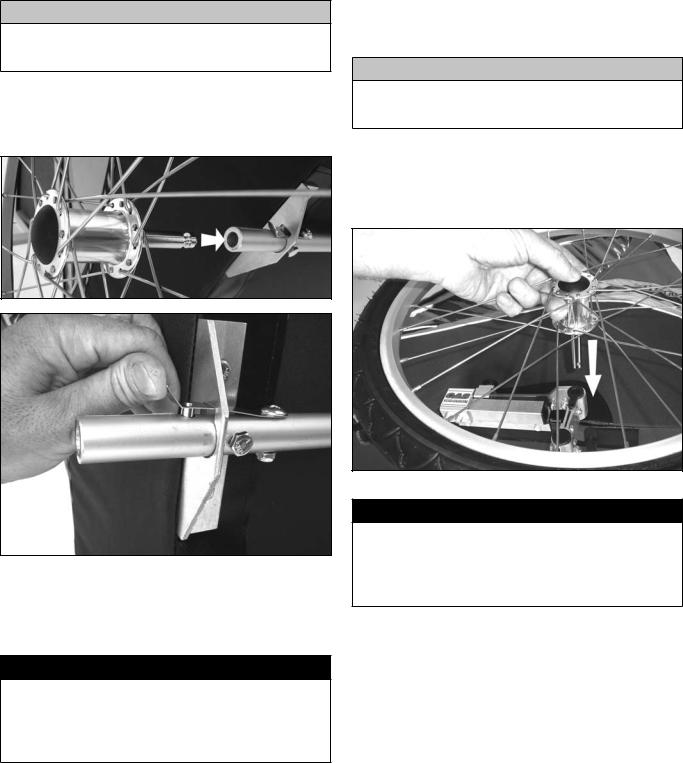
4.3 Wheel assembly
Wheel assembly on the Cabriolet
TIP
The easiest way to assemble the wheel is to lay the carrier on its side.
To assemble the wheel, push the axle into the axle socket until it can go no further. As you do this, the spring clip of the axle socket must audibly engage in the axle groove of the wheel.
Spring clip
Test for proper assembly by trying to pull the wheel outwards after assembling. The wheel’s axle should remain locked in the axle socket and cannot be pulled outwards.
DANGER
Always check that both wheels are properly seated by pulling the wheel hard to one side. To do this, lift the carrier, and make sure that the fi tted wheel cannot be pulled off, by giving it a few good shakes on each side.
To remove the wheel, pull the spring clip out of the hole in the axle socket and pull the wheel out of the axle socket.
Wheel assembly on the Captain XL and Corsaire XL
The wheels of the Captain XL and Corsaire XL are equipped with so-called push-button axles. Pressing on the rubber cap in the wheel centre will loosen the retaining balls which lock the axle in the axle socket. The wheels can only be assembled and removed with the plastic cap pushed in.
TIP
The easiest way to fi t the wheel is to lay the carrier on its side.
To fi t the wheel, press in the rubber cap and insert the wheel axle into the axle socket until it can go no further. Release the rubber cap. By moving the wheel from side to side, check that it is locked in the axle socket and cannot be pulled off.
DANGER
Always check that both wheels are properly seated by pulling the wheel hard to one side without pressing the unlocking button. To do this, lift the carrier, and make sure that the fi tted wheel cannot be pulled off, by giving it a few good shakes on each side.
8
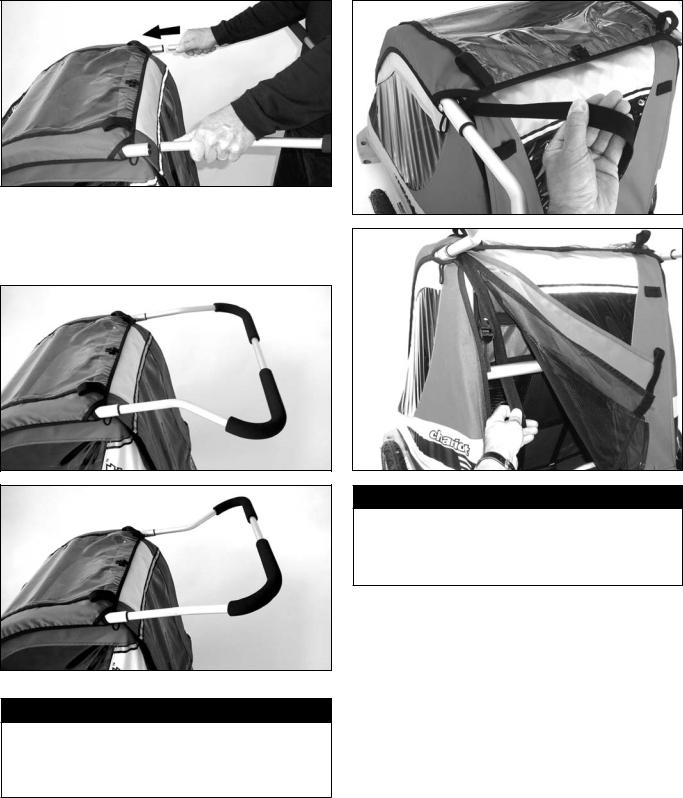
4.4 Fitting the handlebar
Push the handlebar into the upper frame open tube ends. Depress both spring buttons simultaneously and push both ends of the handlebar at the same time into the tube ends until the spring buttons engage.
The handlebar can be height adjusted for two different positions: remove by depressing the spring buttons together, pull out the handlebar, rotate it 180° and re-insert the handlebar into the tube ends.
Safety wrist strap
On the rear left upper frame tube, as seen in the direction of travel, there is the safety wrist strap, which is required to secure the carrier to the wrist when using it as a Jogging Stroller or Stroller. In all other carrier uses, this wrist strap should be stored safely in the storage compartment at the rear of the carrier.
DANGER
Always make sure the safety wrist strap is safely stored in the storage compartment when it is not in use. If this is not done it could get caught in the wheel spokes, and this may result in an accident.
DANGER
Before each journey make sure that the spring buttons of the handlebar are fully engaged. A handlebar that works loose may have serious safety consequences, especially when the carrier is used as a Jogging Stroller or Stroller.
9

4.5 Seat and seatbelts
With the tried and tested 5-point seatbelt system, your children are securely and comfortably strapped into the Chariot.
The Captain XL and Corsaire XL have an additional cross brace in the frame, which is there to anchor the waist belts and brace the seat.
12.On each side of the buckle, the waist belt has a loose belt end for adjusting to fi t correctly on the child. Adjust the waist belt until it is tight and the buckle is in the centre in front of the crotch belt.
13.Finally check that all belts are tight. However, avoid putting too much pressure on the child’s body.
14.Make sure that the padded shoulder harness’s belt position is correctly adjusted, as described below.
padded shoulder harness
buckle of the shoulder harness (under tab)
lap belt
crotch harness
To fasten the child into the carrier, proceed as follows:
1.The shoulder harness always stays fastened to the crotch belt by their shared middle buckle.
2.Undo both of the top buckles of the padded shoulder harness on the back rest. Take off the shoulder harness towards the front.
3.Open the waist belt.
4.Place the child on the seat.
5.Make sure that the crotch belt is between the child’s legs.
6.The shoulder harness’s upper two buckles are attached to vertical straps. Now move both upper buckles until they are directly above the shoulders of the child.
7.Draw the shoulder harness upwards over the child’s shoulders and click both of the upper buckles into their respective buckles on the vertical straps. Make sure that you do not pinch the child’s neck with the buckles.
8.Once again make sure that the crotch belt is between the child’s legs.
9.All belts can be adjusted. The shoulder harness can be adjusted to fi t correctly by pulling tight or loosening the loose ends of the upper securing straps to equal degrees. The loose end of the crotch belt can be pulled tight or loosened like this as well.
10.Adjust the shoulder harness and crotch belt to fi t so that all belts are tight and the lower end of the padded shoulder harness with the “Chariot” logo is level with the child’s lower chest region.
11.Fasten the waist belt. The waist belt must be on the outside of the crotch belt.
Adjusting the padded shoulder harness
To achieve the correct size of the padded shoulder harness, sleeve through or remove the shoulder belts with the plastic buckle through these adjustment loops, as indicated below:
XS: Do not sleeve through any adjustment loops; thus unsleeve the shoulder belts from all loops. (without illustration)
S: Only sleeve through the lowest webbing loop. When sized for XS and S, the un-used, upper sections of the shoulder harness go loose over the children‘s shoulders. Smooth them down their back for comfort.
10

M: Sleeve through both webbing loops. This is the default setting.
L: Sleeve through both webbing loops and the top cord loop.
TIP
Always sleeve or unsleeve the shoulder belts as described above equally on both sides of the padded shoulder harness, otherwise the shoulder harness will not sit properly, and correct fi t of the seatbelts is not possible.
TIP
Depending on manufacturing tolerance, the above mentioned loops may turn out to be too narrow to pull the buckles through them. To make unthreading easier in this situation, you can unthread the buckles and then rethread them as in the illustration below.
Comparison of different adjustments of the padded shoulder harness for children of different heights.
DANGER
Always make sure you thread the belt through correctly (see illustration above). If this is not the case, the belt could slip out of the buckle. This would result in the seatbelt failing, with potentially serious or fatal consequences for your child in the event of an accident.
Whenever you thread the belt through again, always give it a good pull to check that it cannot be pulled out of the buckle.
DANGER
Always make sure the seatbelts are correctly fastened around your child. If this is not the case, your child could be seriously or even fatally injured in the event of an accident. Always make sure the seatbelts are correctly adjusted to the height of your child.
DANGER
Before each journey check all buckles. If this is not done, the belt system may fail in the event of an emergency, with the serious consequences mentioned above.
DANGER
Always take particular care that the shoulder harness is correctly adjusted for height, as described above. In the event of an emergency, incorrect adjustment of the shoulder harness can result in the child getting strangled.
11
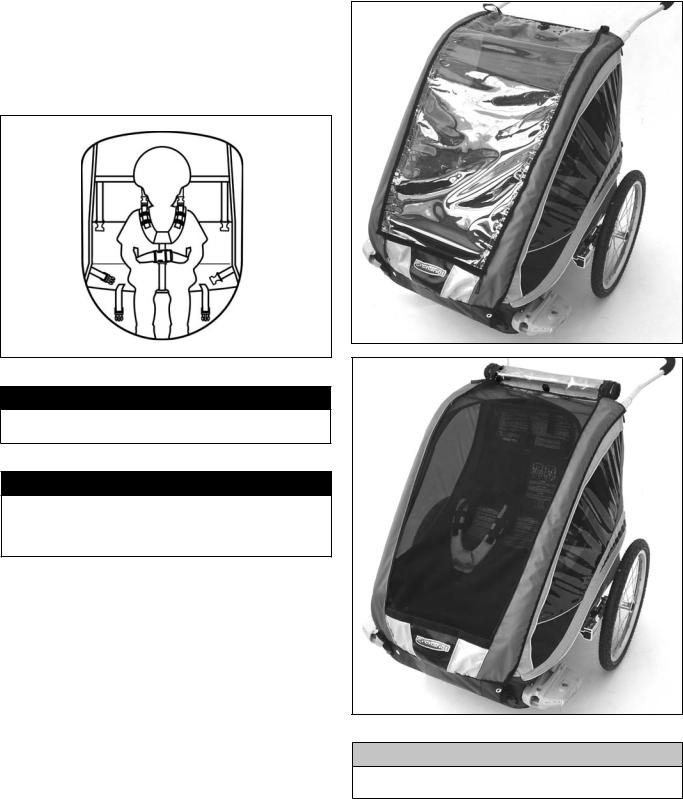
If only one child is being carried, the manufacturer recommends that the child be placed in the centre of the seat.
If you want to use the central sitting position, then strap the child in as follows:
1.Fasten one of the shoulder harnesses to the middle two vertical straps buckles on the backrest.
2.Use the two middle waist belts.
3.Use the additional crotch belt located in the middle of the seat.
4.The second shoulder harness, the two outer crotch belts, and the outer two waist belts are not used.
5.Adjust the belts as previously described.
DANGER
In this case too, all the hazard warnings given above apply!
DANGER
Any other use of the belt system apart from that described is not permitted and may result in your child being seriously or even fatally injured in the event of an accident.
4.6 Climate control
The two-in-one weather cover
All models are equipped with the Chariot two-in-one weather cover, which consists of a plastic window that can be rolled up with mesh beneath it.
TIP
The insect net also provides limited UV protection.
12
